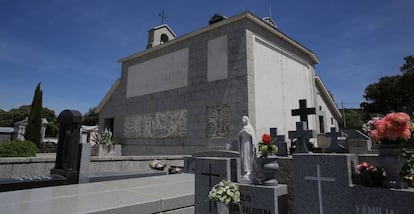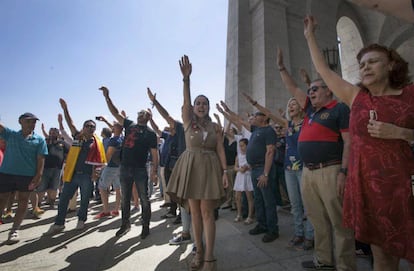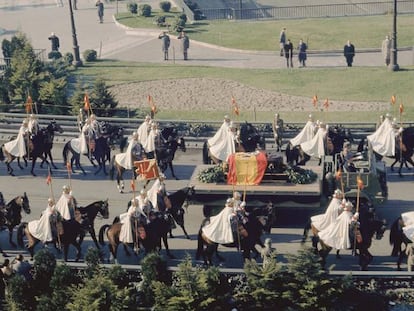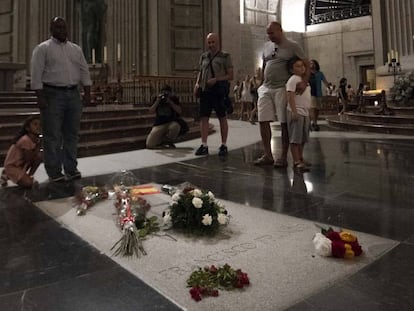Spain¡¯s Supreme Court rules in favor of exhumation of Francisco Franco
The judges examining the appeal by the former dictator¡¯s family have decided that his remains should be taken to the Pardo cemetery, where his wife is buried

The Spanish government will be able to exhume former dictator Francisco Franco from the Valley of the Fallen monument, and take his remains to El Pardo-Mingorrubio cemetery in the north of the Madrid region. That¡¯s according to a ruling today by the Supreme Court, which gives the green light to one of the star policies of the Socialist Party (PSOE) government of caretaker Prime Minister Pedro S¨¢nchez.
The government may be able to transfer Franco¡¯s remains before Spaniards return to the polls on November 10
In a unanimous verdict, the judges from Spain¡¯s top court dismissed the appeal filed by, among others, the grandchildren of Franco, who are bitterly opposed to the PSOE¡¯s plans. They wanted their grandfather to be left where he was, or if he had to be moved, to be taken to the family crypt in La Almudena cathedral in central Madrid. This would have presented a major headache for both the government and the authorities, given the cathedral¡¯s location in one of the capital city¡¯s tourist hotspots.
Spain¡¯s caretaker government has been awaiting this ruling with bated breath. S¨¢nchez¡¯s closest advisors have spent huge amounts of time and effort to make the exhumation a reality, but have constantly come up against judicial rulings and appeals from the family, as well as unforeseen issues with the Spanish Catholic Church.

The worst-case scenario for the government would have been a ruling instructing that Franco be reburied at La Almudena. According to government sources, there would have been no choice but to comply with the decision, but this would have caused a number of issues ¨C not least the fact that Franco would have become the only fascist leader from a major European country who was buried in a cathedral.
The executive managed to secure final approval for the operation on June 10 of this year, but the Supreme Court froze the plan until it had definitively ruled on the appeal, which was filed by the Franco family as well as three other collectives: the Francisco Franco Foundation, the Benedictine community in Cuelgamuros (where the Valley of the Fallen is located), and the Association in Defense of the Valley of the Fallen. The Supreme Court based this decision on the need to avoid irreparable damage to the appellants should the appeal be upheld and the remains of Franco had to be returned to the monument.

The plan to exhume Franco was one of the first announced by S¨¢nchez when he came to power in the summer of 2018. Spain is headed to another general election on November 10, the fourth in four years, but the caretaker government may be able to transfer Franco¡¯s remains before Spaniards return to the polls.
Now that the caretaker government has the blessing of the courts, it simply needs authorization from the Church to enter the basilica at the Valley of the Fallen and exhume the remains. It says that all of the other administrative arrangements have been made.
Despite today¡¯s Supreme Court ruling, there could still be obstacles for the exhumation
But despite today¡¯s Supreme Court ruling, there could still be obstacles for the exhumation. The Franco family has already said that it will file an appeal with the Constitutional Court, which could freeze proceedings until it rules on the case. What¡¯s more, a Madrid judge has suspended the license that will be needed for the actual exhumation work to take place inside the basilica at the Valley of the Fallen. The court took the decision based on a report that was commissioned by the Francisco Franco Foundation, and that concluded that the work moving the 2,000-kilo tombstone would ¡°endanger the safety of workers and property.¡±
Speaking on Tuesday, however, the caretaker deputy prime minister, Carmen Calvo, insisted that the work would be done in a timely fashion. ¡°We will do it very quickly,¡± she told reporters. ¡°The quicker the better, because that is what the ruling calls for, and what¡¯s more, it is better that it happen as far away from the electoral campaign as possible.¡±
Caretaker Prime Minister Pedro S¨¢nchez, who is currently in New York at the United Nations General Assembly, celebrated the ruling via a tweet. ¡°Today we have seen a great victory for Spanish democracy,¡± he wrote in his message. ¡°The determination to redress the suffering of Franco¡¯s victims has always guided the actions of the government. [...] Justice, memory and dignity.¡±
Historical memory law
The PSOE government of Pedro S¨¢nchez made a modification to the Historical Memory Law in order to put their exhumation plan in motion. That controversial piece of legislation was passed more than 10 years ago by his Socialist predecessor, Jos¨¦ Luis Rodr¨ªguez Zapatero, who was prime minister of the Spanish government from 2004 to 2011. The law was aimed at healing some of the wounds left behind by Spain¡¯s bitter civil conflict, including recovering the remains of those who were executed by firing squads, and whose bodies still lie in mass graves and roadside ditches around the country. After Cambodia, Spain ranks second as the country with the highest number of ¡°disappeared¡± people: 114,000 according to historians and relatives¡¯ estimates.
When the conservative Popular Party (PP) came to power in 2011, however, the funding for historical memory projects was slashed. The PSOE included €15 million of new funds in its most recent budget proposal, but failed to get its spending plan approved by Congress, sparking the April 2019 general election. Until a new government is formed, the country¡¯s financial commitment to historical memory projects will remain up in the air.
Valley of the Fallen
The 13.6-square kilometer Valley of the Fallen site remains hotly contested in a country still struggling to come to terms with the legacy of the fascist dictatorship of Franco, who was the Spanish head of state from the end of the Civil War in 1939 to his death in 1975.
The site was ostensibly built to commemorate all of the victims on both sides of Spain's bitter and bloody Civil War (1936-1939), and the unmarked remains of more than 33,000 victims of the conflict lie there. But critics point out that the Valley of the Fallen, which features a basilica and a 150-meter-high cross that dominates the surrounding countryside, contains just two marked graves: those of Franco himself and Jos¨¦ Antonio Primo de Rivera, the founder of the Falange, Spain's fascist-inspired political party. At the same time, thousands of prisoners of war who fought against Franco in the civil conflict were among the workforce used in its construction.
English version by Simon Hunter.
Tu suscripci¨®n se est¨¢ usando en otro dispositivo
?Quieres a?adir otro usuario a tu suscripci¨®n?
Si contin¨²as leyendo en este dispositivo, no se podr¨¢ leer en el otro.
FlechaTu suscripci¨®n se est¨¢ usando en otro dispositivo y solo puedes acceder a EL PA?S desde un dispositivo a la vez.
Si quieres compartir tu cuenta, cambia tu suscripci¨®n a la modalidad Premium, as¨ª podr¨¢s a?adir otro usuario. Cada uno acceder¨¢ con su propia cuenta de email, lo que os permitir¨¢ personalizar vuestra experiencia en EL PA?S.
?Tienes una suscripci¨®n de empresa? Accede aqu¨ª para contratar m¨¢s cuentas.
En el caso de no saber qui¨¦n est¨¢ usando tu cuenta, te recomendamos cambiar tu contrase?a aqu¨ª.
Si decides continuar compartiendo tu cuenta, este mensaje se mostrar¨¢ en tu dispositivo y en el de la otra persona que est¨¢ usando tu cuenta de forma indefinida, afectando a tu experiencia de lectura. Puedes consultar aqu¨ª los t¨¦rminos y condiciones de la suscripci¨®n digital.










































